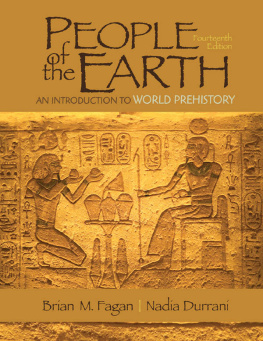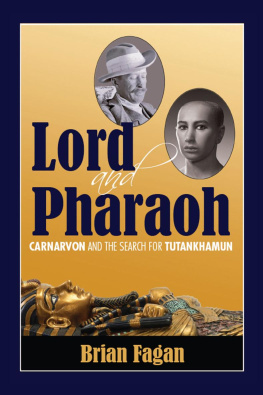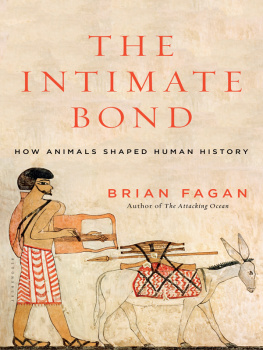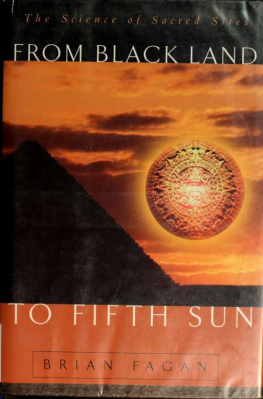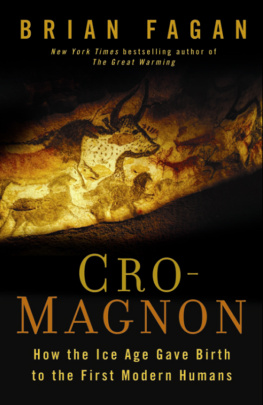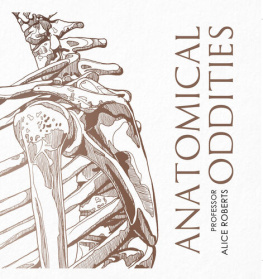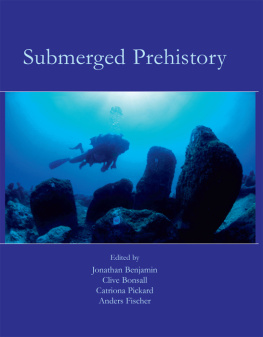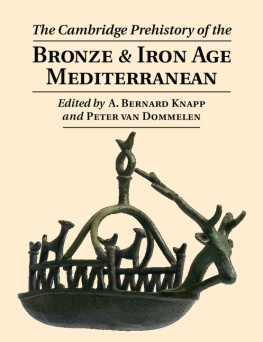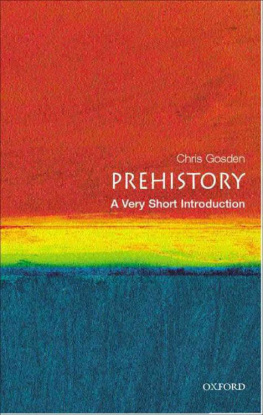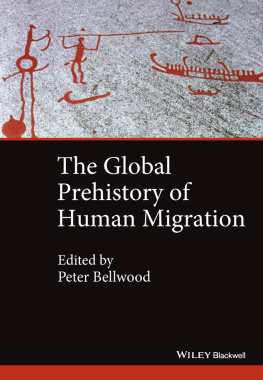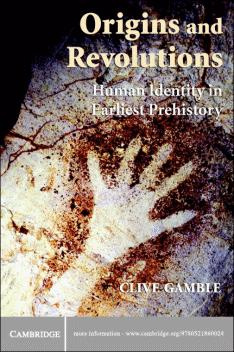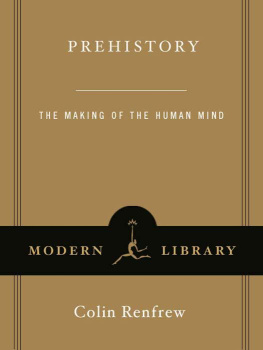PEOPLE OF THE EARTH
PEOPLE OF THE EARTH
An Introduction to World Prehistory
FOURTEENTH EDITION
Brian M. Fagan
Emeritus, University of California, Santa Barbara
and
Nadia Durrani
First published 2014, 2010, 2007 by Pearson Education, Inc.
Published 2016 by Routledge
2 Park Square, Milton Park, Abingdon, Oxon OX14 4RN
711 Third Avenue, New York, NY, 10017, USA
Routledge is an imprint of the Taylor & Francis Group, an informa business
Copyright 2014, 2010, 2007 Taylor & Francis. All rights reserved
All rights reserved. No part of this book may be reprinted or reproduced or utilized in any form or by any electronic, mechanical, or other means, now known or hereafter invented, including photocopying and recording, or in any information storage or retrieval system without permission in writing from the publishers.
Notice:
Product or corporate names may be trademarks or registered trademarks, and are used only for identification and explanation without intent to infringe.
Credits and acknowledgments borrowed from other sources and reproduced, with permission, in this textbook appear on appropriate page within text (oronpages 505507)
ISBN: 9780205966554 (pbk)
Cover Designer: Bruce Kanselaar
Library of Congress Cataloging-in-Publication Data
Fagan, Brian M.
People of the earth: an introduction to world prehistory / Brian M. Fagan and Nadia Durrani. Fourteenth Edition.
pages cm Includes bibliographical references and index
ISBN-13: 978-0-205-96655-4
ISBN-10: 0-205-96655-1
1. Prehistoric peoples. 2. Civilization, Ancient. I. Durrani, Nadia. II. Title.
GN740.F33 2013
569.9dc23
2013019027
To
All the dozens of archaeologists and students who have read and used this book in its various editions and sent me their comments and criticisms. This is the only way we can thank them all and expose them for what they are: honest and unmerciful critics. We are deeply grateful.
And, as usual, to Brians cats, who disapprove of authors in general and of his writing efforts in particular. Their contribution was to tread on his computer keyboardwith muddy paws, of course. Thanks also to Matthew, and to Nadias baby Jacobwho joins Brians cats inmuddy paws and disapproval.
Brief Contents
Contents
G olden pharaohs, lost cities, grinning human skeletonsarchaeology is the stuff of romance and legend. Many people still think of archaeologists as adventurers and treasure hunters, like Indiana Jones of Hollywood movie fame seeking the elusive Crystal Skull. This enduring image goes back to the late nineteenth century, when archaeologists like Heinrich Schliemann of Troy fame could still find lost civilizations and excavate three royal palaces in a week. Today, no archaeologists behave like Indiana Jones. They are scientists, not adventurers, as comfortable in an air-conditioned laboratory as they are on a remote excavation.
The development of scientific archaeology from its Victorian beginnings ranked among the greatest triumphs of twentieth-century science. Archaeology has changed our perceptions of ourselves in profound ways, giving us a better understanding of our biological and cultural diversity. Welcome to the fascinating world of archaeology!
New to This Edition
Nadia Durrani has joined Brian Fagan as coauthor for this and future editions. She brings a wealth of practical experience in Yemen and other places, as well as a background in archaeological journalism and journal editing.
introduces world prehistory and presents new insights on the human past, including the latest theoretical advances.
have been completely reorganized and rewritten. They reflect new thinking and recent discoveries that alter our perceptions of the archaic world and human origins.
.
presents the latest evidence on the first settlement of the Americas. New sites and innovative hypotheses enliven the long debates on the subject.
includes new information on changes in hunter-gatherer societies at the end of the Ice Age, especially in Southwest Asia.
has been completely rewritten and updated to include the exciting discoveries of recent years that are changing our ideas on early farming in Southwest Asia profoundly, including climate change.
have been updated with new information and recent discoveries.
has been updated to include the latest theories on the origins of states and civilizations.
now reflect the latest discoveries on such topics as Stonehenge and the Shang civilization.
on Native American civilizations have been revised throughout to keep up with a new torrent of finds and fresh perceptions.
Science and Site boxes throughout the text cover key concepts like radiocarbon dating and present important new discoveries (and some older well-known ones) in more detail. Many are newly written for this edition. Examples include the spectacular Grotte de Chauvet cave paintings in France and the Lords of Sipn from coastal Peru, one of the most important archaeological discoveries of the twentieth century.
There are major changes in the illustrations throughout the book.
This fourteenth edition of People of the Earth comes at a time when new discoveries and archaeological methodologies are deeply affecting our understanding of the human past. This edition continues a nearly 40-year tradition of clear, jargon-free writing for the beginning student, the incorporation of the latest scholarship, and an accessible (five-part) organization of the story of world prehistory. This is a straightforward narrative, written by two authors (not the work of multiple scholars), which gives the book a coherence often lacking in edited volumes. The basic objective is a simple one: to provide an interesting journey through the 7-million-year-old landscape of the human past. At the same time, the book attempts to achieve geographic balance, giving equal time to both well-trodden and less well-known parts of the world. Any world prehistory that does otherwise is presenting a skewed picture of the human past. People of the Earth is an adventure in archaeology. We hope you enjoy your sojourn in its pages.
Writing a straightforward narrative of human prehistory is a mammoth task, especially at a time when a torrent of new literature about archaeological discoveries around the world is revolutionizing our knowledge of the remote past. We are well beyond the point where only two authors can possibly hope to keep up with every new find and intellectual development in world archaeology, but we have done our best, while trying to keep the narrative as simple and uncluttered as possible, without undue emphasis on individual sites or human societies.
This narrative of world prehistory is divided into five parts. includes coverage of the new AMS radiocarbon chronology for first settlement, made possible by extended calibration curves. After the Ice, which follows, leads into the chapters on the first farmers.
devoted to the theoretical background and the following five chapters discussing the earliest farming in different areas of the world. New discussions in this edition include the increasing impact of refined AMS chronologies, genetic fingerprinting of potentially domesticable animals and plants, and a fresh generation of research into the origins of rice cultivation. Important new perceptions of the Mississippian and other, more complex farming societies in eastern North America also receive extended treatment.
Next page
